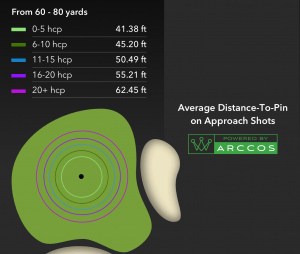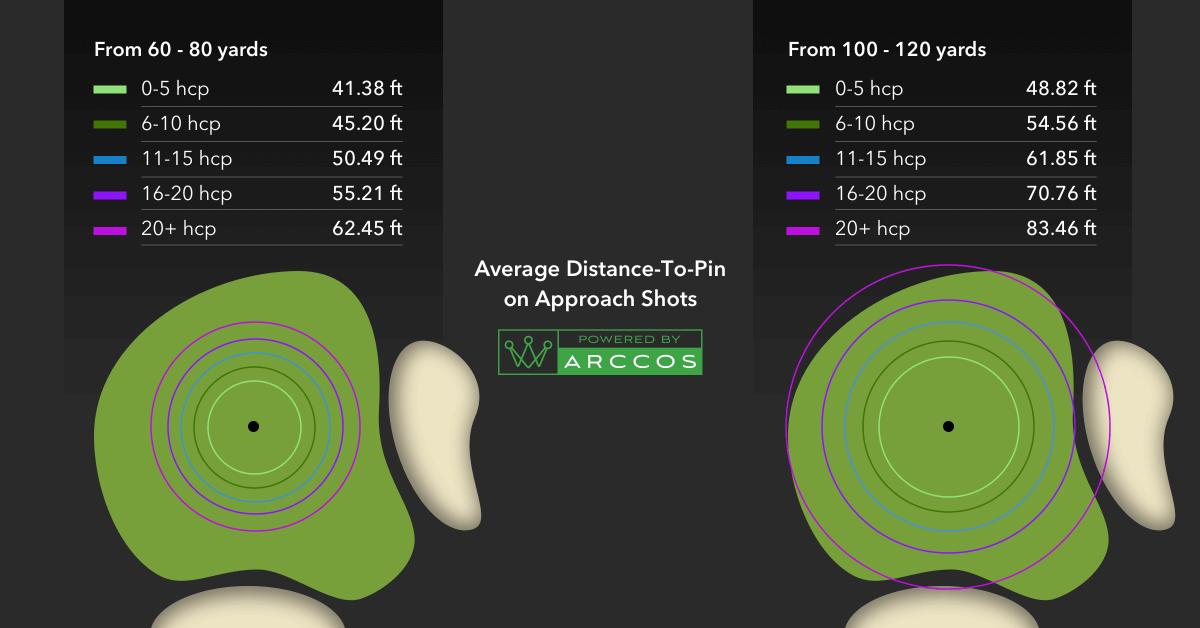What’s your go-to club for approach shots? That question can be bantered around your foursome and the answers would be legion. Some will know precisely what number they prefer. Others will guess a range. The majority likely wouldn’t be sure.
PGA Tour pros know this answer immediately. You can as well, but the only way to make this assessment is by using data.
Using the massive Arccos database that incorporates more than 100 million shots from nearly two million rounds, we split golfers into handicap brackets and analyzed each group’s proximity to the hole on approach shots from two yardage buckets: 60-80 yards and 100-120 yards. We wanted to find the yardage most people should try to navigate toward when laying up on a par-5 or punching out on a par-4.
With Arccos, golfers can automatically track stats on the course and use that information gathered to shoot lower scores. Arccos records on-course performance data via sensors installed in the grips of clubs. The system automatically records and analyzes all of a golfer’s stats, uses Artificial Intelligence to show a personalized strategy for every shot and leverages advanced analytics to inform practice regimens.
The results are clear: Every handicap bracket hits it closer from 60-80 yards versus 100-120 yards. (You’re probably saying duh, but stay with us!) The data also reveals a potential performance gap in a habitually forgotten practice area: the half-wedge.
The 0-5 handicap has a proximity to the hole of 41.38 feet from 60-80 yards out. Comparatively, the 20+ handicap has a proximity of 62.43 feet from that same range. That 21 feet difference will consistently contribute to more three-putts on a player’s card, giving the illusion that putting is the problem. Data reveals the truth – the higher handicappers need to start working some wedge distance control into their practice routines.
From 100-120 yards, the 0-5 handicap bracket performs relatively close to their 60-80 yard averages. There’s only about a 7-foot difference in proximity to the hole from the farther distance. However, moving back in yardage dramatically changes the proximity to the hole for the higher handicap players. The 20+ handicapper averages 83 feet from the hole on wedge shots from 100-120 yards. That’s about 21 feet farther than their distance from 60-80 yards!
As a point of reference, PGA Tour players average 19’ 7” from the hole on shots from 100-125 yards.
The data suggests that golfers should lay up as close as possible, and the logical extension of that is that they should also dedicate a big portion of practice time to wedge play.
Average Distance to the Pin on Approach from 60-80 yards
- 0-5 handicap: 41.38 feet
- 6-10 handicap: 45.20 feet
- 11-15 handicap: 50.49 feet
- 16-20 handicap: 55.21 yards
- 20+ handicap: 62.43 feet
Average Distance to the Pin on Approach from 100-120 yards
- 0-5 handicap: 48.82 feet
- 6-10 handicap: 54.56 feet
- 11-15 handicap: 61.85 feet
- 16-20 handicap: 70.76 feet
- 20+ handicap: 83.46 feet
Every golfer is unique, but Arccos can help every player know the best strategy for their game. While on the course, tapping the “Caddie” button in the Arccos Caddie app reveals your optimal strategy on any shot from any point on the course. For a deeper dive, Arccos users can look at club performance for every wedge to learn which club has the best proximity to the hole. Then look at that club’s Smart Distance and voila, that’s your target layup zone.
Tour pros make carefully calculated decisions for every shot on the course. Some of the most informative PGA Tour coverage involves a player and his caddie hashing out what club to hit off the tee, how to construct a recovery shot or whether or not to go for the green. Often that process involves working backward from the green. With Arccos, amateurs can do the same.
















Sean
5 years ago
41 ft, seems far for a 0-5 handicap . At anything under 100 yards I can get inside 30 feet easily everytime. I’m a 6 handicap . If you go out and practice twice a week hitting 100 balls each time with your 54 wedge you should be able to get inside 20ft pretty regularly. Practice is the key. Puttting and wedges are way overlooked on the range. My buddies go out and hit 10 7 irons and 90 driver. Wedges and putting are the key.